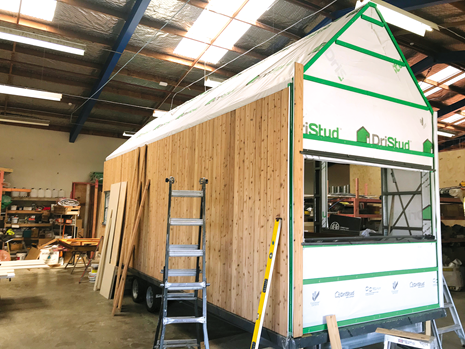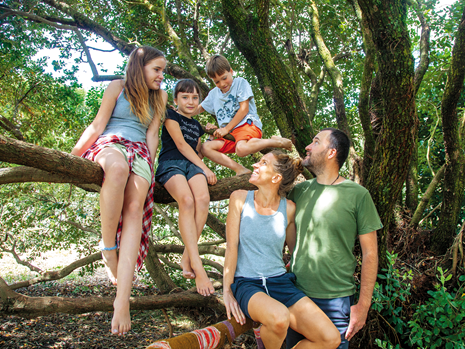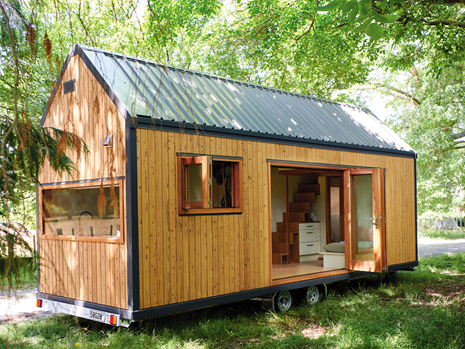Feature: Le Workshop tiny houses
Farm Trader chats with Hawke’s Bay couple Francois and Sarah-Lee Guittenit who are gathering quite a reputation for their exquisite tiny houses
 |
|
Easily transportable – if you get tired of one site, it can be easily moved to another
|
Customers are buying these tiny homes for a wide variety of reasons: from gaining extra space for a family member or running as an Airbnb business, to using as an office, a personal retreat, or for those wishing to downsize their existing homes.
A shared love of building and design
Francois spent seven years training as a cabinet maker in France (he’s from Brittany) and has always loved the design aspect of building.
 |
|
Sarah-Lee and Francois Guittenit
|
When he met Sarah-Lee, an artist and designer, it became a truly creative partnership and Le Workshop was born.
"We’ve always loved designing spaces together, especially small spaces. From a design perspective, it’s more challenging, but it also makes it more exciting," says Sarah-Lee.
Visiting the family, we chat around a sturdy rimu wooden table, built by Francois, as the couple’s two youngest children LouLou and Francis flit in and out like bright little birds.
Francois and Sarah-Lee home-school their three children and Francois does most of his design work from this same table.
 |
|
A tiny house takes shape in Le Workshop at Onekawa
|
"It’s all very workable," he says in answer to my query of what is it like living in a small space with a family and home-schooling them?
"Everything happens from home as much as possible and if we feel like going for a bike ride or some other outdoor activity, we just go for it," says Francois.
Having a flexible schedule that includes the children and being able to do the outdoor activities they love is an integral part of their lives.
The family moved from Auckland because the city lifestyle didn’t allow for such spontaneity. Sarah-Lee’s family live in Hawke’s Bay, so that was another reason to move.
"When you have children, your priorities change. We wanted to be more relaxed and closer to nature, to be able to go outside, and in Auckland, that wasn’t so easy. So, we moved and in 2017 began Le Workshop, a cabinet-making business on land we bought at Awatoto."
The couple built a 21sqm house to live in.
"We lived in this space for three years and found this experience brought us together and simplified our values. As a result, we established Le Workshop Tiny Houses," says Francois.
Their home drew the attention of many interested passers-by.
"People stopped to chat to us about what it was like to live in a small space," says Sarah-Lee.
The couple then moved to the coastal settlement of Haumoana because they found living next to the main road felt too busy. For now, they are living in a slightly larger house than a tiny house.
Tiny house construction
When Francois and Sarah-Lee begin a new design, it becomes a collaborative effort between them and their client.
 |
|
Every available space is utilised for storage without it seeming cluttered
|
"We’ve never designed our houses to be purchased off-the-shelf; instead, we enjoy sitting down with our clients to work out their individual needs. We generally start with the size that they need."
Le Workshop designs offer three building lengths and one width because the final tiny home needs to fit onto a trailer.
"Then we talk about layouts; some people don’t want steps, so we have a downstairs bedroom option. Overall, we offer flexible and unique, individual designs; it’s never the same twice. Clients love the fact that once completed, their home reflects them."
 |
|
The kitchen has a view and even manages to fit in a place to sit and eat
|
Francois uses Japanese cedar for the outside cladding and American cedar for windows and joinery. The windows are double glazed, and the walls packed with wool insulation. Underfloor insulation is a wood fibre made in Germany. The final product needs to meet the legal requirements of 3.5 tonnes or less to transport on-site, and these lighter timbers fulfil that purpose.
As for other utilities, clients need water on-site. There is no black water (flushing toilet) but instead a composting toilet and electricity is via a caravan plug. Solar power is also offered.
Clever storage
Sarah-Lee’s creative designs include as much storage without the space feeling cluttered.
"One family wanted a daybed couch in their lounge with lift-up storage for suitcases for weekend guests. We can do as much storage as possible, but we don’t want it to look like a caravan. We want it to feel like a home that’s not too cluttered."
.png) |
|
You can sit on the couch and still feel connected to the outside
|
Their plywood-clad interiors are warm and inviting. All mod cons are on offer, from dish drawers to washing machines. One client wanted a bath, so that went in too. They also offer tiny fireplaces, which add to the atmosphere.
"The idea of gathering wood and lighting a fire has a romantic appeal.
"The bifold doors can be opened up, and if the weather turns bad you can curl up with a cup of teas and a book on the window seat and watch the elements but remain warm and cosy," says Sarah-Lee.
Francois adds, "If a person uses a wheelchair, I can build custom-made doors, bed, and benchtop. I love to provide distinctive features. It’s good to see an owner with the final product and know they are happy."
"What we try to achieve with our designs is that quintessential Kiwi, indoor-outdoor flow to give a connection with nature. I think there should be a connection, a dialogue between land and home, rather than as separate entities. We love the Department of Conservation (DOC) huts, the feeling of arriving, resting, gathering, sharing around a fireplace, surrounded by nature."
On-site delivery
When it comes to delivery, distance is no problem. The tiny house and trailer are hooked onto Francois and Sarah-Lee’s UTE and with the whole family on-board, off they go. If a site is steep or difficult to access, sometimes a tractor is used for extra muscle. Decks and steps are added on arrival at the site.
 |
|
Sarah-Lee and Francois with their children Poppy, LouLou, and Francis
|
"Because the children are home-schooled, we can work wherever we are. We’ve delivered to Christchurch, and next year we are going to Nelson and Golden Bay. It’s good for the children, and they get to meet all sorts of people and experience New Zealand. They have been from the top to the bottom of our islands. Along the way, we get lots of notice, so they love it when drivers toot and wave.
"Most people build a deck on front; some have an outside bath or whatever they want. It’s a perfect additional dwelling for a farm and as mentioned, provides another income stream. Guests can enjoy an authentic, on-farm experience, have a tour around the farm or watch cows being milked, and enjoy a litre of fresh milk afterwards," says Sarah-Lee.
"If a farmer wants to put his house somewhere remote and there’s no electricity, a solar power system can be installed so the heating source is then fire with gas for hot water and cooking," adds Francois.
Back to the land
Francois says they have created several tiny houses for families who’ve decided that living on the same piece of land is a good option.
"Lifestyle blocks often have an ample amount of land, and so the resources are there to find a spot for a tiny house. We’ve built for Airbnb but also for full-time living for older clients. They find it more economical than having a big house. It means they can move on the land where they have their kids and their grandkids, and it all makes sense.
 |
|
Decking is added after the tiny house is in place. This one is located on Waiheke Island.
|
"I understand you don’t necessarily want to live in the same house as your parents, so the tiny house provides a separate living space while remaining nearby."
City dwellers are also finding the tiny houses appealing and being compact can be readily installed on an urban section.
For Francois, Sarah-Lee, and their children, their business allows them to have an enjoyable lifestyle without losing any quality.
"We can work and generate income and provide the right environment for the kids to learn. It also means we can have holidays, go skiing, and so all those things that are financially accessible because we have low living costs. The memories of childhood will be enhanced by those experiences, rather than having a costly house."
The family also run a beekeeping business, Bee Fruitful, with 500 hives. It’s rewarding and also gives them an additional income stream.
"It’s good to diversify and not have all your eggs in one basket. As we’ve seen this year, there are uncertainties in all types of work. Although I like designing and building, I couldn’t do it eight hours a day, every day. Working outside with nature is good," says Francois.
The couple seems to have achieved a perfect balance and say it’s important to both of them to have meaningful work.
"It’s good when you are doing a business and lead a lifestyle that can benefit society as much as possible."
For more information on the business, visit leworkshop.co.nz.
Keep up to date in the industry by signing up to Farm Trader's free newsletter or liking us on Facebook






.jpeg)
.jpg)




.gif)
.gif)

1-(1).gif)

